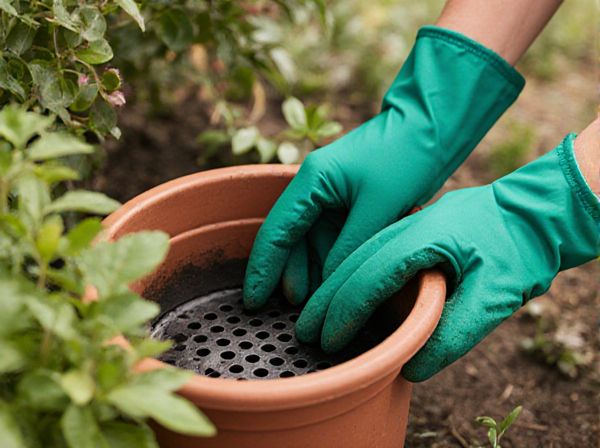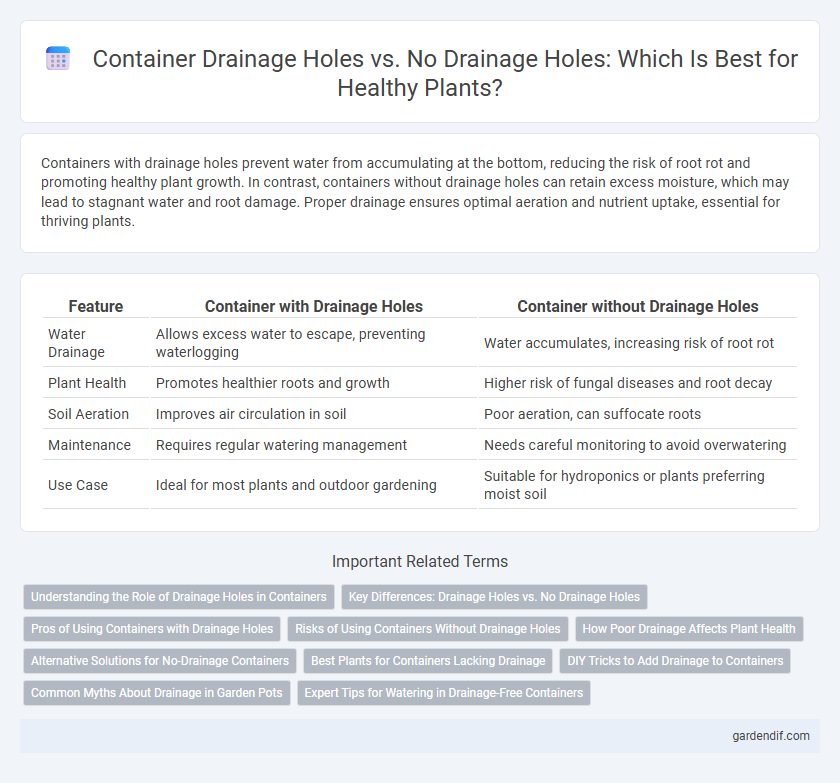
Container drainage holes vs no drainage holes Illustration
Containers with drainage holes prevent water from accumulating at the bottom, reducing the risk of root rot and promoting healthy plant growth. In contrast, containers without drainage holes can retain excess moisture, which may lead to stagnant water and root damage. Proper drainage ensures optimal aeration and nutrient uptake, essential for thriving plants.
Table of Comparison
| Feature | Container with Drainage Holes | Container without Drainage Holes |
|---|---|---|
| Water Drainage | Allows excess water to escape, preventing waterlogging | Water accumulates, increasing risk of root rot |
| Plant Health | Promotes healthier roots and growth | Higher risk of fungal diseases and root decay |
| Soil Aeration | Improves air circulation in soil | Poor aeration, can suffocate roots |
| Maintenance | Requires regular watering management | Needs careful monitoring to avoid overwatering |
| Use Case | Ideal for most plants and outdoor gardening | Suitable for hydroponics or plants preferring moist soil |
Understanding the Role of Drainage Holes in Containers
Drainage holes in containers play a crucial role in preventing waterlogging by allowing excess water to escape, which reduces the risk of root rot and promotes healthy plant growth. Containers without drainage holes can trap water, leading to poor oxygen circulation around the roots and increasing the likelihood of fungal diseases. Proper container drainage ensures optimal moisture levels, essential for maintaining plant health and enhancing nutrient uptake.
Key Differences: Drainage Holes vs. No Drainage Holes
Containers with drainage holes prevent waterlogging by allowing excess water to escape, promoting healthy root growth and reducing the risk of root rot. Containers without drainage holes may retain excess moisture, increasing the likelihood of fungal diseases and root decay, but they are suitable for plants requiring consistent moisture levels. Proper container selection depends on the specific watering needs of the plant and the container's drainage capabilities.
Pros of Using Containers with Drainage Holes
Containers with drainage holes prevent waterlogging by allowing excess water to escape, promoting healthier root growth and reducing the risk of root rot. These holes enhance aeration in the soil, improving oxygen availability to roots and supporting optimal plant development. Effective water management in containers with drainage holes is essential for maintaining balanced moisture levels and preventing nutrient depletion.
Risks of Using Containers Without Drainage Holes
Containers without drainage holes pose significant risks such as waterlogging, which leads to root rot and fungal infections by trapping excess moisture around plant roots. Insufficient drainage also reduces oxygen availability in the soil, impairing root respiration and nutrient absorption crucial for plant health. Prolonged water retention in container soil fosters a breeding ground for harmful pathogens and pests, ultimately diminishing plant growth and survival rates.
How Poor Drainage Affects Plant Health
Containers without drainage holes often cause water to accumulate, leading to root rot and oxygen deprivation that severely impair plant health. Excess moisture creates an environment conducive to fungal diseases and nutrient leaching, preventing roots from absorbing essential minerals effectively. Proper drainage ensures optimal aeration, promoting robust root systems and reducing the risk of plant stress and mortality.
Alternative Solutions for No-Drainage Containers
No-drainage containers can prevent soil leakage and reduce mess indoors, making them ideal for certain plants and environments. Alternative solutions such as self-watering systems, moisture-retentive soils, and internal water reservoirs help maintain proper hydration and aeration without drainage holes. Using a layer of activated charcoal or hydroton beneath the soil improves drainage and prevents root rot by creating a water buffer within the container.
Best Plants for Containers Lacking Drainage
Containers without drainage holes require careful plant selection to prevent waterlogging and root rot. Succulents like aloe vera, snake plants, and jade plants thrive in these environments due to their drought tolerance and minimal watering needs. Orchids and certain air plants also perform well in non-draining containers by benefiting from controlled moisture levels and frequent air circulation.
DIY Tricks to Add Drainage to Containers
Container drainage holes prevent waterlogging by allowing excess water to escape, promoting healthy root growth and preventing root rot. For containers without pre-drilled holes, DIY tricks include using a drill or a heated nail to create drainage, adding a layer of gravel or broken pottery at the bottom to facilitate water movement, and elevating the container on small feet or pot risers to improve airflow and drainage. These simple methods enhance soil aeration and moisture control, supporting thriving plants in any container garden.
Common Myths About Drainage in Garden Pots
Many gardeners believe that containers without drainage holes cause root rot, but certain self-watering pots and lined containers are designed to manage moisture effectively without excess water escaping. Another common myth is that drainage holes always prevent overwatering; however, improper watering techniques or poor soil quality often contribute more to plant health issues than the presence or absence of holes. Selecting the right container material and soil mix can be more critical than simply relying on drainage holes for healthy root development.
Expert Tips for Watering in Drainage-Free Containers
Watering drainage-free containers requires precise control to prevent root rot and overwatering. Experts recommend using a moisture meter and watering slowly, allowing water to absorb evenly without pooling. Incorporating materials like activated charcoal or hydrogel crystals can improve aeration and water retention in containers without drainage holes.
Container drainage holes vs no drainage holes Infographic

 gardendif.com
gardendif.com